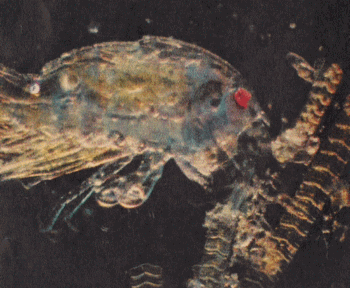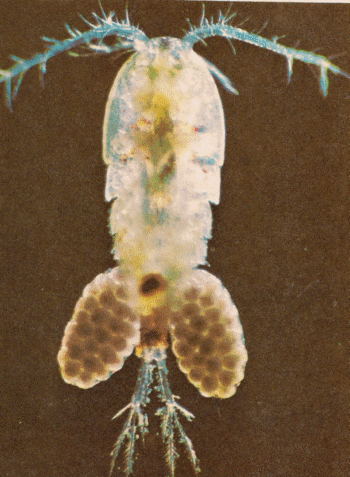 SKC Films Library |
| SKC Films Library >> Science >> Zoology >> Crustaceans >> Subclass Copepoda |
| About Copepods Copepods are small, usually free-swimming, crustaceans which occur in both freshwater and the sea, where they form a major part of the plankton upon which larger animals feed. The word "copepod" comes from Greek words meaning "oar-feet." There are over 4,500 species of copepods, distributed among 10 orders. The vast majority of copepods are less than a millimeter long, but a few marine species can be over a centimeter in length. All have segmented bodies covered with stiff bristles called setae, a hard exoskeleton, two pairs of antennae (one long, one short), and many pairs of legs (5 pairs being the most common). Most have only one eye, colored black or red, on top of the head. The eye, which in some species is only present in the larval stage, can only differentiate between light and dark. Free-swimming copepods are common in all freshwaters, particularly in stagnant ponds, as well as all oceans and seas except in the Arctic and Antarctic. The larvae are generally attracted to sunlight and inhabit the upper parts of water, whereas adults tend to live at lower depths. Some copepods use their legs to swim about, while others swim by alternately bending and straightening their bodies. These latter copepods spend most of their time crawling about over algae or other aquatic vegetation. Larval copepods often move differently from the adults, in jerky rushes followed by a period of floating or free gliding. Copepods exhibit a wide range of feeding behaviors. Some eat tiny floating plants, such as diatoms and algae. Others filter small particles of food from the water with a complex sieving mechanism, the limbs around the mouth setting up a continuous pulsating movement that drives water through the sieve. There are also copepods that capture and eat relatively large animals, including other copepods. A number of copepods, which are mainly marine, are parasitic on fish. These are usually found on the inside of the gill covers, where they suck the fish's blood. copepod eating a diatom larger than
itself swarm of parasitic copepods
(fish-lice) on the side of a John Dory Copepod reproductive methods vary somewhat by species, but in most the female, which is almost always much larger than the male, lays her eggs in an egg-sac (or sacs) attached to her body. A few lay their eggs directly into the water. Some freshwater copepods are able to avoid the effects of unfavorable conditions, such as excessive cold or drought, by producing two types of egg. One type develops rapidly and hatches in a few days, while the other, larger and more resistant, type lies on the bottom of the pool or lake and takes weeks to develop. It is probably through the second egg type that copepods are dispersed, the eggs becoming attached to the muddy feet of aquatic birds and carried from one stretch of water to another. Larvae are completely different from adults and typically go through 11 moults before reaching their final form and size. Some copepods go through their entire life cycle in about a week, while others may live as adults for up to 6 months. female copepod (water-flea) with
two large egg-sacs While copepods themselves do not tend to fall prey to parasites, many species of parasites, including tapeworms and flukes, rely on copepods for part of their life cycle. Scientific Classification phylum Arthropoda |
| SKC Films Library >> Science >> Zoology >> Crustaceans >> Subclass Copepoda This page was last updated on March 24, 2018. |


